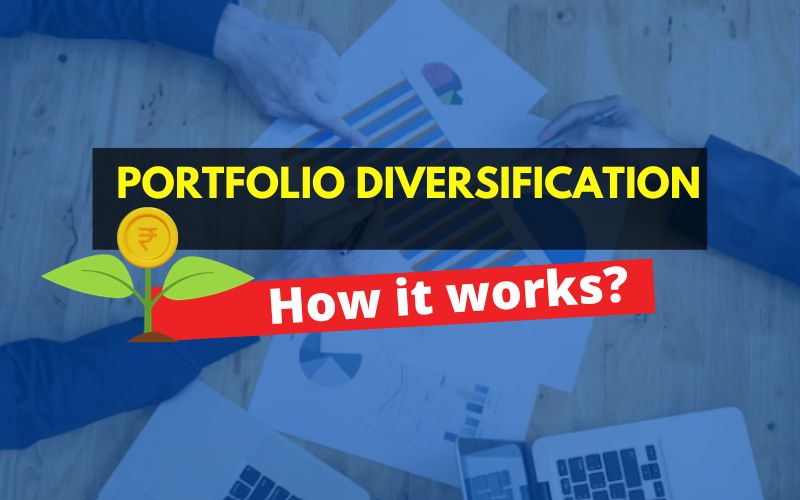Portfolio and diversification is a fundamental investment strategy that helps balance risk and return by spreading investments across various asset classes like debt, equity, gold, and real estate. The concept is based on saying, “Don’t put all your eggs in one basket.”
The idea behind portfolio diversification is to reduce a portfolio’s overall risk by minimizing the impact of a poor-performing asset on the entire investment portfolio. In this article, I will discuss portfolio diversification, its benefits, and how to diversify your portfolio effectively.

Table of Contents
What is Investment Portfolio Diversification?
Investment portfolio diversification is a strategy that involves spreading your investment principal across various assets to reduce risk and potentially improve long-term returns.
The concept is based on the idea that by not putting all of your money into a single investment or asset class, you can decrease the impact of poor performance in one area of your portfolio on the overall performance of your investments.
Why Build a Diversified Portfolio?
The primary objectives of investment portfolio diversification are:
- ✅To Safeguard Invested Principal: Diversification helps protect your capital by reducing the risk of losing a substantial portion of your investments due to a downturn in a particular asset class.
- ✅Risk Reduction: Diversification helps mitigate (minimize) the impact of poor performance in a single investment. By spreading your investments, you reduce the risk of significant capital losses, as losses in one asset can be offset by gains in others.
- ✅Stable Returns: A diversified portfolio is more likely to provide stable and predictable returns. In contrast, individual assets may experience volatility.
- ✅Enhanced Risk-Return Trade-off: Through diversification, you aim to achieve a balance between risk and return that supports your financial goals and risk tolerance. Diversification allows you to optimize your portfolio’s potential for returns while managing the associated risks.
Risk Return Trade-off: How Diversification Reduces Portfolio Risk?
The risk-return trade-off is the basic concept in investing that highlights the relationship between the level of risk associated with an investment and the potential returns it offers. Simply put, the higher the risk, the higher the expected return, and the lower the risk, the lower the expected return.
Let’s understand how diversification reduces portfolio risk with the following examples:
- Example-1: Debt & Equity
- Assume you want to take a calculated risk and take equity exposure of 50% based on goal-based financial planning. You decided to safeguard your invested principal up to 50% of the portfolio; hence, you invested 50% in debt investments like FD, RD, and post office instruments. With diversification, you planned and reduced 50% of the risk of your portfolio.
- However, a certain level of risk is always associated. In debt, it’s interest rate risk.
- Example-2: Equity Fund-A and Equity Fund-B
- Assume you have Rs. 1 lakh and want to invest equally. The expected return of these funds depends upon the economic state.
| Economic State | Probability | Hypothetical | Probability | |||
| Return on Fund-A | Return on Fund-B | Return on Fund-A | Return on Fund-B | Return on Portfolio (Fund A+Fund B) | ||
| State-1 | 0.2 | 15% | -5% | 3.% | -1% | 5% |
| State-2 | 0.2 | -5% | 15% | -1% | 3% | 5% |
| State-3 | 0.2 | 5% | 25% | 1% | 5% | 15% |
| State-4 | 0.2 | 35% | 5% | 7% | 1% | 20% |
| State-5 | 0.2 | 25% | 35% | 5% | 7% | 30% |
| Expected Return | 15% | 15% | 15% | |||
The above table depicts expected returns in Fund-A, Fund-B, and Portfolio (Fund A+ Fund B). This makes it challenging to decide which fund to pick, or you may blindly choose any one rather than taking the pain of creating a portfolio.
Here, I introduce the Standard deviation, which will help us analyze the volatility of a fund (risk-associated). The higher the standard deviation, the more volatile the fund. A lower standard deviation is better. While shortlisting the funds, look for funds with lower Standard deviation.
Standard Deviation = Probability x (Hypothetical Return – Expected Return)
| Economic State | Probability | Hypothetical | Expected | Standard deviation | ||||||
| Return on Fund-A | Return on Fund-B | Return on Portfolio (Fund A+Fund B) | Fund-A Return | Fund-B Return | Portfolio Return | Fund-A | Fund-B | Portfolio (Fund A+Fund B) | ||
| State-1 | 0.2 | 15 | -5 | 5 | 15 | 15 | 15 | 0 | 80 | 20 |
| State-2 | 0.2 | -5 | 15 | 5 | 15 | 15 | 15 | 80 | 0 | 20 |
| State-3 | 0.2 | 5 | 25 | 15 | 15 | 15 | 15 | 20 | 20 | 0 |
| State-4 | 0.2 | 35 | 5 | 2 | 15 | 15 | 15 | 80 | 20 | 5 |
| State-5 | 0.2 | 25 | 35 | 3 | 15 | 15 | 15 | 20 | 80 | 45 |
| Standard Deviation | 14.14% | 14.14% | 9.49% | |||||||
The above table depicts that the standard deviation of Fund-A and Fund-B is the same, 14.14%, whereas for the Portfolio (Fund A+ Fund B), it’s lesser, i.e., 9.49%, which proves a diversified portfolio can reduce risk.
Read More: Risk-Return Trade-Off: How They Affect Your Investments?
Portfolio and Diversification: Benefits of Portfolio Diversification
There are many benefits of portfolio diversification. However, I would like to focus on mainly two:
1. Risk Reduction and Mitigation
When it comes to investment, risk reduction, and risk mitigation play a vital role. As we learned above, risk reduction focuses on reducing risk by introducing safe assets like debt or creating a portfolio. A balanced portfolio with different asset classes like debt, equity, gold, and real estate helps reduce risk.
However, risk mitigation focuses on minimizing the adverse effects of a risk after it has occurred. While it may not prevent the risk, it aims to limit the impact and speed up recovery.
Standard risk mitigation strategies include creating a contingency/emergency fund taking proper insurance coverage (life insurance, health insurance, and critical illness insurance). By creating an emergency fund and taking insurance, you don’t prevent the risk but prepare to minimize the financial impact to recover the loss quickly.
2. Enhanced Stability in Different Market Conditions
Portfolio diversification enhances stability in different market conditions by spreading the risk associated with investments across various asset classes. When assets are distributed in a well-diversified portfolio, their performance can behave differently under different market conditions.
Here’s how portfolio diversification enhances stability in various market scenarios:
- 🔹Market Volatility: Assume you have a 100% equity portfolio compared to 50% debt and 50% equity exposure. In periods of market volatility, the equity portfolio will have significant price fluctuations, whereas debt will have no impact. Hence, with diversification, you can stabilize your portfolio to some extent.
- 🔹Reality: In India, individuals often take higher exposure to real estate and gold, thinking they are stable and safe. However, you may feel stuck at a time of need if real estate or gold value has gone down. It is not that real estate is stable, just that it is not as transparent as the equity market. Hence, you feel it’s stable, and gold is bought with a long-term investment intention, mostly jewelry, so you don’t check the rate daily. Hence, you feel it’s stable.
- 🔹Alignment with Risk Tolerance: Diversifying a portfolio allows investors to align their risk tolerance with their investment strategy. For those with a lower risk tolerance, a diversified portfolio with higher exposure to debt can provide excellent stability and peace of mind.
- 🔹Long-Term Consistency: A diversified portfolio can deliver more consistent returns over the long term. While some assets may experience short-term underperformance, others may perform well, smoothing overall returns. This consistency can help investors stay on track with their financial goals and reduce the emotional toll of investing.
Portfolio and Diversification: How to Diversify Your Portfolio?
Goal-based investing is the best way to diversify your portfolio. When you work on goal-based financial planning, experts help you diversify your overall portfolio viz goal-wise diversification; this enables you to keep your goal achievable and stable portfolio.
Here are steps to help you effectively diversify your investment portfolio:
➡️Set Clear Investment Goals and Risk Tolerance
The first step before diversification is to set clear investment objectives and assess your risk-taking ability. Consider your financial goals, time horizon, and willingness to withstand market fluctuations. Your risk tolerance will influence your asset allocation and diversification strategy.
➡️Diversify within Asset Classes
- Do not focus on one asset class; diversify your investment.
- – Equity: Long-term goal
- – Debt: Short-term goal
- – Gold: ETF, SGB
- – Real Estate: Residential property for living
➡️Rebalance Regularly
Periodically rebalancing your portfolio is the best way to ensure your asset allocation is on track. Remember, like a balanced food for being healthy, a balanced portfolio is a must for a healthy portfolio.
➡️Consult Professional
Consult a financial advisor for guidance on portfolio diversification. They can provide customized advice based on your financial goals.
Why is Rebalancing Essential in Portfolio Diversification?
✔️Risk Management
Rebalancing helps manage risk by preventing your portfolio from becoming overconcentrated in any asset class. If one asset class significantly outperforms the others, it can increase its portfolio share and expose you to higher risk. By rebalancing, you reduce this concentration risk and maintain a more balanced profile.
✔️Achieving Consistency
Rebalancing can help you achieve a more consistent and stable return. By regularly rebalancing your portfolio to its target allocation, you can avoid the risk of experiencing excessive volatility during market downturns.
✔️Adapting to Changing Goals or Risk Tolerance
As your financial goals or risk tolerance changes over time, your target asset allocation may need to be adjusted. Rebalancing allows you to re-align your portfolio with your evolving objectives and risk tolerance.
The Impact of Asset Allocation on Short-Term Volatility and Long-Term Performance
Effective asset allocation requires careful consideration of an investor’s goals, risk tolerance, and investment horizon. It provides a strategic framework for optimizing returns while managing risks and fluctuations in the investment portfolio.
Short-Term Volatility
- Liquidity Management: Asset allocation based on financial planning considers the liquidity needs of investors.
- Volatility Reduction: Asset allocation can be used to reduce short-term volatility by including less volatile assets in the portfolio. For example, investing in a liquid fund or FD for an emergency fund and short-term goals.
- Mitigation of Downside Risk: A well-structured asset allocation can protect the downside during market downturns.
Long-Term Performance
- Alignment with Goals: The asset allocation should align with an individual’s long-term financial goals and investment horizon. A long-term investor with a high-risk tolerance might allocate a significant portion to equity for potential capital appreciation. In contrast, a conservative investor with short-term goals might favor debt instruments for capital preservation.
- Risk Management: Asset allocation helps in managing risk. A well-balanced allocation considers an investor’s risk tolerance and investment goals.
- Return Potential: Asset allocation significantly impacts a portfolio’s long-term returns. The distribution of investments across asset classes, such as equity and debt, determines the overall return potential.
- Diversification: Asset allocation, when done correctly, allows for diversification, which can enhance long-term performance.
- Compounding Returns: Over the long term, the compounding effect of returns on a diversified portfolio can lead to substantial wealth accumulation. Consistent, positive returns over time can be more effectively achieved through proper asset allocation.
Conclusion
In summary, asset allocation is a fundamental driver of an investment portfolio’s long-term performance and ability to manage short-term volatility. The allocation of assets across different asset classes influences the overall risk-return profile of the portfolio. Effective asset allocation requires careful consideration of an investor’s goals, risk tolerance, and investment horizon. It provides a strategic framework for optimizing returns while managing risks and fluctuations in the investment portfolio.








